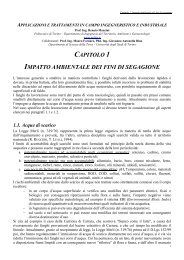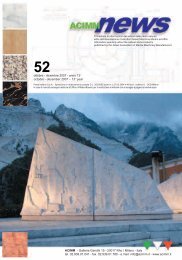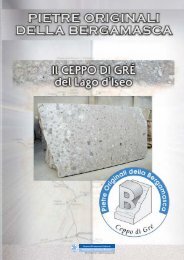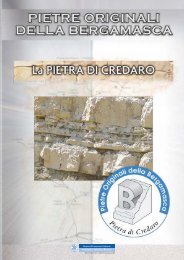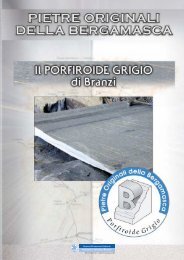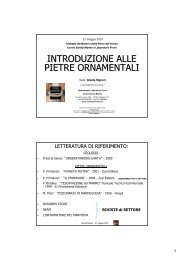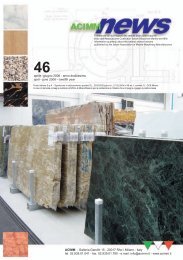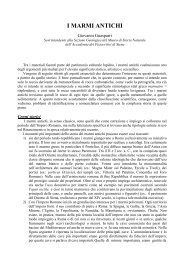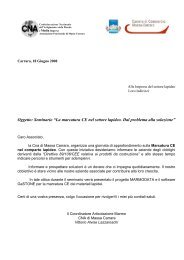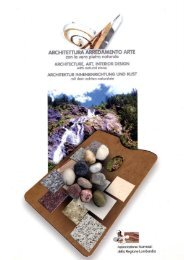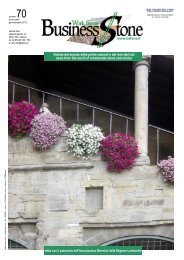Pagina singola_1A - natural stone info
Pagina singola_1A - natural stone info
Pagina singola_1A - natural stone info
You also want an ePaper? Increase the reach of your titles
YUMPU automatically turns print PDFs into web optimized ePapers that Google loves.
Sviluppo sostenibile<br />
e attività estrattiva sulle Alpi.<br />
Sustainable development and quarrying in the Alps<br />
Sviluppo sostenibile per il turismo e la cultura,<br />
ma sviluppo sostenibile anche per chi lavora i materiali<br />
tipici che sono legno, ferro, pietre che danno<br />
lavoro tutto l’anno e non solo durante le vacanze<br />
ed è per questo che da alcuni anni si è<br />
formato nell’ambito dell’Associazione Lombardia<br />
(ma liberamente aperto a tutte le altre Associazioni<br />
lapidee presenti nell’arco alpino) il Comitato<br />
Pietre delle Alpi per spiegare che l’estrazione della<br />
pietra non è più distruttiva, che il lavoro evita lo<br />
spopolamento delle montagne anche a beneficio<br />
della loro conservazione e che mantiene viva la<br />
cultura dei luoghi con l’impiego dei materiali delle<br />
tradizioni la cui salvaguardia è la principale garanzia<br />
di continuità.<br />
Oltre a dar voce alle necessità di un<br />
lavoro, reso difficile da una rigida burocrazia,<br />
cerca di far incontare le ragioni<br />
eco-compatibili con le esigenze<br />
produttive. Riassunte in un convegno<br />
in Val Camonica, le opinioni<br />
autorevoli del professor<br />
Alessandro Ubertazzi<br />
del Politecnico di Milano che<br />
ha invitato a cambiare mentalità:<br />
“Si può scavare rispettando<br />
le pietre incise ed a<br />
proposito di ripristino, lasciamo<br />
le cave, monumenti al lavoro<br />
umano, come sono,<br />
aperte e pulite.., ma anche<br />
il settore si deve organizzare<br />
con progetti, investimenti,<br />
impegno ad <strong>info</strong>rmare e<br />
coinvolgere i progettisti nel mondo per poter vendere<br />
materiali con una fiaba dietro”.<br />
Sustainable development for tourism and culture,<br />
but sustainable development also for those<br />
who work traditional materials: wood, iron and<br />
<strong>stone</strong>, which provide work all year round and not<br />
just during the holiday season. For this reason<br />
the Comitato Pietre delle Alpi was set up some<br />
years ago by the Associazione Lombardia (but<br />
open to all other <strong>stone</strong> associations operating in<br />
the alpine area). The Committee‚s purpose is to<br />
explain that the quarrying of <strong>stone</strong> is no longer<br />
destructive and the work avoids the depopulation<br />
of the mountainside, thus helping its conservation<br />
and guaranteeing the continuity of the local culture<br />
by safeguarding the use of traditional<br />
materials.<br />
As well as giving voice to the need for this work,<br />
which is made difficult by a lot of red tape, it also<br />
tries to achieve a compromise between<br />
respect for the environment and the<br />
demands of production. At a Convention<br />
in Val Camonica the authoritative words<br />
of Professor Alessandro<br />
Ubertazzi of Milan<br />
Polytechnic summed up the<br />
situation thus: „We can<br />
quarry with respect for the<br />
<strong>stone</strong>s that are cut; on the<br />
subject of renewal, we<br />
should leave the quarries as<br />
they are, open and clean,<br />
as a monument to human<br />
toil”.., but the sector must<br />
also get organised with<br />
projects, investment,<br />
commitment to <strong>info</strong>rm and<br />
involve planners all over the world in order to be<br />
able to sell a material that has a story behind it”.<br />
○ ○ ○ ○ ○ ○ ○ ○ ○ ○ ○ ○ ○ ○ ○ ○ ○ ○ ○ ○ ○ ○ ○ ○ ○ ○ ○ ○ ○ ○ ○ ○ ○ ○ ○ ○ ○ ○ ○ ○ ○ ○ ○ ○ ○ ○ ○ ○ ○ ○<br />
○ ○ ○ ○ ○ ○ ○ ○ ○ ○ ○ ○ ○ ○ ○ ○ ○ ○ ○ ○ ○ ○ ○ ○ ○ ○ ○ ○ ○ ○ ○ ○ ○ ○ ○ ○ ○ ○ ○ ○ ○ ○ ○ ○ ○ ○ ○ ○ ○ ○ ○ ○<br />
Il Professor Architetto<br />
Alessandro Ubertazzi<br />
doscente di disegno<br />
industriale al Politecnico<br />
di Milano e Preside della<br />
Facoltà di Architettura<br />
all’Università di Firenze<br />
Professor Alessandro<br />
Ubertazzi, architect and<br />
lecturer in industrial<br />
design at Milan<br />
Polytechnic and Head of<br />
the Faculty of<br />
Architecture at Florence<br />
University.<br />
Antico e moderno.<br />
A sinistra un vecchio<br />
pavimento dell’alta valle<br />
Brembana - Bergamo<br />
A destra il pavimento in<br />
Arabescato Orobico<br />
della nuovissima Fiera<br />
di Bergamo.<br />
Ancient and modern<br />
On the left an old floor in<br />
the upper Brembana<br />
valley ˆ Bergamo.<br />
On the right flooring in<br />
Arabescato Orobico in<br />
the brand new Bergamo<br />
Fair.<br />
7




